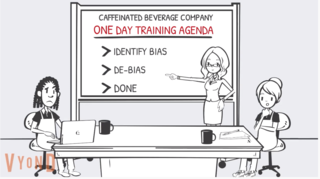Bias
Are Diversity Activists Focused on the Wrong Solution?
Biases, biology, and why one-day anti-bias training often fails to work.
Posted October 22, 2019

On a recent podcast, I talked to Chris Davis, Associate Director of Harvard Extension’s Career and Academic Resource Center, and discussed why many diversity programs and initiatives tend to fail.
Research shows that programs aimed at outlawing bias and prejudice are generally ineffective. Most diversity training programs encourage people to "value and appreciate" diversity. Most diversity programs have an agenda to promote, and they have the solution too.
They begin with the assumption that there is a solution, such as reducing bias or eliminating prejudice. They assume that all we need to do is to get rid of our "wrong" values and beliefs. Hence, most diversity programs start with an agenda and assume they have the correct solution. However, there are studies that suggest commanding people to change their beliefs or behaviors can trigger oppositional behavior. Most people don't like being told what to think or how to behave.
In addition, the diversity training field is split, one might say, into two groups of professionals. There are researchers who study bias and prejudice or maybe develop scales for measuring bias, but they don't practice in a real-world setting. So, companies, universities, and organizations generally have to hire another group of professionals, the practitioners, to conduct diversity training programs in a real-world setting.
That's not to say one group is better than the other. Rather it is to underscore that there is a split in the field of diversity training. This situation is very similar to clinical psychology. Often in clinical psychology, you have clinicians out there delivering psychotherapy services, and then you have another group of professionals doing research on psychotherapy.
So, there is a divide between the practice of psychotherapy and the theory of psychotherapy. And that is what we are seeing in diversity training programs as well. There are researchers who may never have applied their research in practice and practitioners who are unfamiliar with the research. Though diversity researchers have developed many bias measures, at the level of practice, in real-world settings, removing biases does not seem to work. Telling people that they are biased may, in fact, produce a backlash and close conversations rather than open up conversations.
The very label “bias” can be interpreted as a pre-emptive pejorative. It can close minds and end conversations.
In my forthcoming book The Science of Diversity ® and my course at Harvard, "The Psychology of Diversity," we underscore that there is no simple solution. We live in a society where we want quick, simple solutions; we want to be able to solve our problems in 10 minutes.
We know that a recent incident at a coffee house sparked an anti-bias training. It was held in one day. As if it might be possible to conduct diversity training programs by telling people: “You have a bias, de-bias,” and we're done! I think it would be great if we could do that. But removing biases is not a surgical procedure.
And that's what the forthcoming book, The Science of Diversity, demonstrates. It's not a surgical procedure because biologically our biases are tied into our very identities and attachments. Asking people to get rid of their biases is biologically improbable. We are constrained by our biological make-up.
The book offers researchers and practitioners a new way to view diversity from a scientific viewpoint and practical suggestions on how to apply the science of diversity in real-world settings, taking into account biological research.
However, when areas of science, such as diversity, are contentious, a missing fact is not the sole core of the problem, and supplying the public with more scientific information is not the sole solution. Equally or more important is also teaching the public to think scientifically, and to learn to evaluate the scientific information contained in the communication. As a professor and researcher, I have had a ringside seat to the power of scientific thinking. I have also seen how attainable this skill is.
Copyright © Mona Sue Weissmark All Rights Reserved
Watch the short video below explaining “Why are Diversity Activists Focused on the Wrong Solution?" and "Is Banning Bias Possible?"
References
Jacobs, Lizbeth. [Lizbeth Jacobs]. (2019, August 22). Is Banning Bias possible? [Video file]. Retrieved from https://youtu.be/D9AxoQC8Jvc
Weissmark, M. (forthcoming 2019). The Science of Diversity. Oxford University Press, USA.
Weissmark, M. (2004). Justice Matters: Legacies of the Holocaust and World War II. Oxford University Press, USA.
Weissmark, M. & Giacomo, D. (1998). Doing Psychotherapy Effectively. University of Chicago Press, USA.




